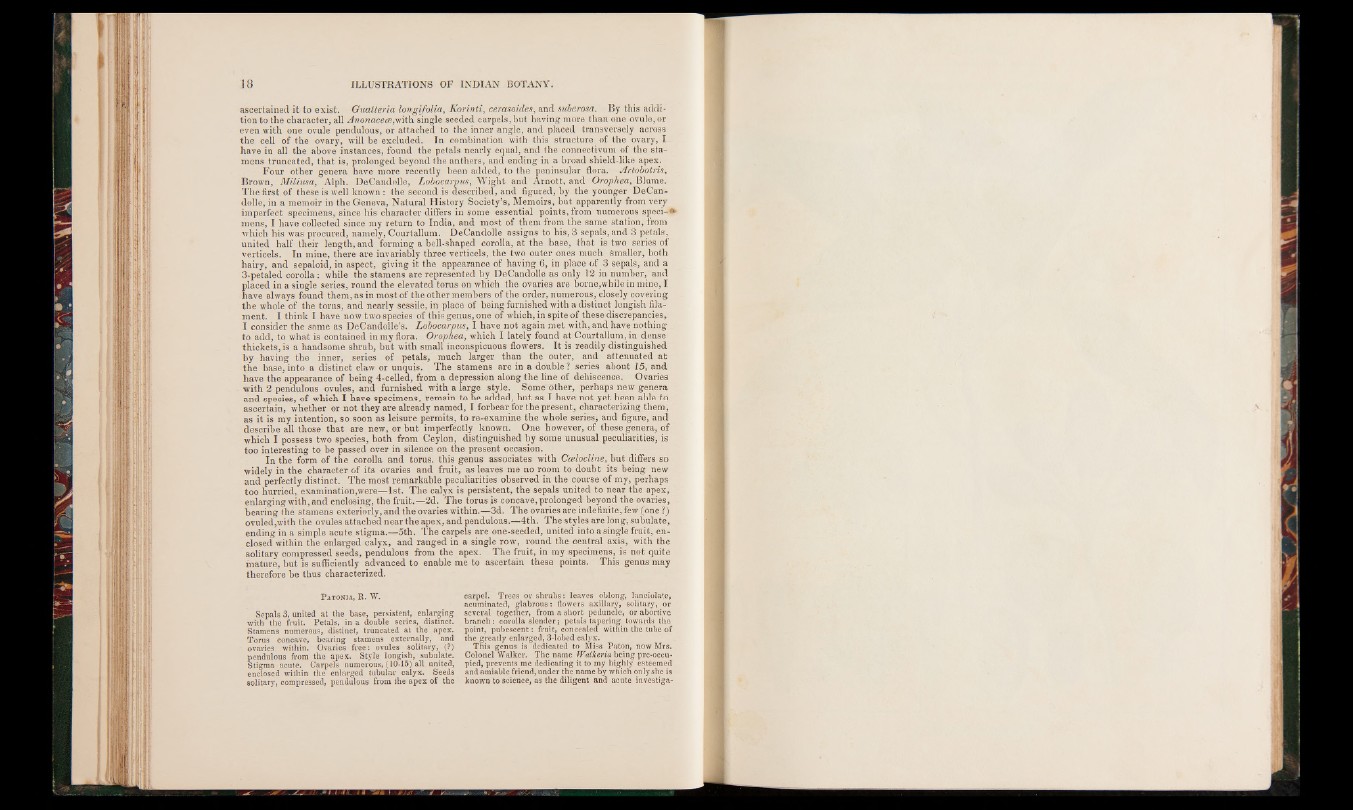
ascertained it to exist. Guatteria longifolia, Korinti, cerasoides, and suberosa. By this addition
to the character, all Anonacece,with single seeded carpels, but having more than one ovule, or
even with one ovule pendulous, or attached to the inner angle, and placed transversely across
the cell of the ovary, will be excluded. In combination with this structure of the ovary, I
have in all the above instances, found the petals nearly equal, and the connectivum of the stamens
truncated, that is, prolonged beyond the anthers, and ending in a broad shield-like apex.
Four other genera have more recently been added, to the peninsular flora. Artobotris,
Brown, Miliusa, Alph. DeCandolle, Lobocarpus, Wight and Arnott, and Orophea, Blume.
The first of these is well known : the second is described, and figured, by the younger DeCandolle,
in a memoir in the Geneva, Natural History Society’s, Memoirs, but apparently from very
imperfect specimens, since his character differs in some essential points, from numerous speci-t*
mens, I have collected since my return to India, and most of them from the same station, from
which his was procured, namely, Courtallum. DeCandolle assigns to his, 3 sepals, and 3 petals,
united half their length, and forming a bell-shaped corolla, at the base, that is two series of
verticels. In mine, there are invariably three verticels, the two outer ones much smaller, both
hairy, and sepaloid, in aspect, giving it the appearance of having 6, in place of 3 sepals, and a
3-petaled corolla: while the stamens are represented by DeCandolle as only 12 in number, and
placed in a single series, round the elevated torus on which the ovaries are borne,while in mine, I
have always found them, as in most of the other members of the order, numerous, closely covering
the whole of the torus, and nearly sessile, in place of being furnished with a distinct longish filament.
I think I have now two species of this genus, one of which, in spite of these discrepancies,
I consider the same as DeCandolle's. Lobocarpus, I have not again met with, and have nothing
to add, to what is contained in my flora. Orophea, which I lately found at Courtallum, in dense
thickets, is a handsome shrub, but with small inconspicuous flowers. It is readily distinguished
by having the inner, series of petals, much larger than the outer, and attenuated at
the base,into a distinct claw or unquis. The stamens are in a double? series about 15, and
have the appearance of being 4-cellea, from a depression along the line of dehiscence. Ovaries
with 2 pendulous ovules, and furnished with a large style. Some other, perhaps new genera
and species, of which I have specimens, remain to be added, but as I have not yet been able to
ascertain, whether or not they are already named, I forbear for the present, characterizing them,
as it is my intention, so soon as leisure permits, to re-examine the whole series, and figure, and
describe all those that are new, or but imperfectly known. One however, of these genera, of
which I possess two species, both from Ceylon, distinguished by some unusual, peculiarities, is
too interesting to be passed over in silence on the present occasion.
In the form of the corolla and torus, this genus associates with Ccelocline, but differs so
widely in the character of its ovaries and fruit, as leaves me no room to doubt its being new
and perfectly distinct. The most remarkable peculiarities observed in the course of my, perhaps
too hurried, examination,were—1st. The calyx is persistent, the sepals united to near the apex,
enlarging with, and enclosing, the fruit.—2d. The torus jg concave, prolonged beyond the ovaries,
bearing the stamens exteriorly, and the ovaries within.—3d. The ovaries are indefinite, few (one ?)
ovuled,with the ovules attached near the apex, and pendulous.—4th. The styles are long, subulate,
ending in a simple acute stigma.—5th. The carpels are one-seeded, united into a single fruit, enclosed
within the enlarged calyx, and ranged in a single row, round the central axis, with the
solitary compressed seeds, pendulous from the apex. The fruit, in my specimens, is not quite
mature, but is sufficiently advanced to enable me to ascertain these points. This genus may
therefore be thus characterized.
P atonia, R. W.
Sepals 3, united at the base, persistent, enlarging
with the fruit. Petals, in a double series, distinct.
Stamens numerous, distinct, truncated at the apex.
Torus concave, bearing stamens externally, and
ovaries within. Ovaries free: ovules solitary, (?)
pendulous from the apex. Style longish, subulate.
Stigma acute. Carpels numerous, (10-15) all united,
enclosed within the enlarged tubular calyx. Seeds
solitary, compressed, pendulous from the apex of the
carpel. Trees or shrubs: leaves oblong, lanciolate,
acuminated, glabrous: flowers axillary, solitary, or
several together, from a short peduncle, or abortive
branch: corolla slender; petals tapering towards the
point, pubescent: fruit, concealed within the tube of
the greatly enlarged, 3-lobed calyx.
This genus is dedicated to Miss Paton, now Mrs.
Colonel Walker. The name Watkeria being pre-occu-
pied, prevents me dedicating it to my highly esteemed
and amiable friend, under the name by which only she is
known to science, as the diligent and acute investiga